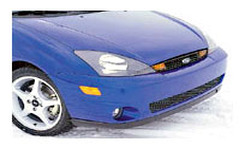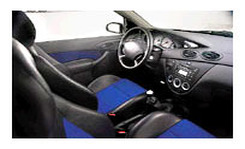In late 1999, the year the compact Ford Focus was introduced, we tested a concept vehicle -- the turbocharged 220-hp Focus R -- and fearlessly predicted it would soon fill a hole in the lineup of hot cars turned out by Ford's Special Vehicle Team (SVT). That hole was created by Ford when it handed the SVT Contour its walking papers. We also predicted that another souped-up Focus, possibly dubbed the Focus GT, would likely show up with a non-turbo 160-hp version of the stock car's 130-hp four-cylinder engine.
Turns out we were half-right. There will be an SVT Focus in showrooms by the end of this year. It won't be a turbo, but it will have substantial performance upgrades. As for the turbocharged Focus R concept car, it remains just that -- a concept.
Judging by our brief look-see of the SVT Focus that you see on this page, we are not lamenting the absence of a turbo under the hood. And if SVT can get the front office to go along with a hoped-for price of $18,500, this car could set a bang-for-the-buck record. Here's why.

The body stuff works, looking quite aggressive but tasteful, too.
The engine is a thoroughly massaged revision of the 130-hp, 2.0-liter Zetec four-cylinder. Although the displacement remains the same at 2.0 liters, the SVT folks modified numerous pieces to increase engine airflow while preserving low-end torque. Chief among the tweaks are variable intake camshaft timing and a two-stage intake manifold that allows optimal airflow at both low and high engine speeds. Expelling the air is the job of new exhaust headers and a high-flow catalytic converter. The pistons are new, too, and they bump the compression ratio from 9.6:1 to 10.2:1; that and stronger connecting rods result in a lofty 7500-rpm redline.
SVT has yet to finalize the modified engine's power rating, but our crystal ball says 170 ponies is a good wager. What's more, 80 percent of peak torque (145 pound-feet) will be available at a low 2000 rpm.
What surprised us most about the SVT Focus was the type of transmission chosen for the job. Rather than use the standard five-speed unit -- the predictable move -- SVT opted for a new six-speed manual box made by Getrag. There are also beefier half-shafts and uprights to handle the extra power. Although the SVT Focus won't dust a Corvette's nose at a stoplight launch, it should drop the Focus ZX3's 0-to-60-mph run of 8.7 seconds into the seven-second range.

The dash houses the cluster of luminescent-green gauges that have become an SVT trademark.
As SVT boss John Coletti explained the details of the new car, we were getting the idea that nothing was left untouched in the SVT transformation. Exclusive to the SVT's suspension are its bushings, springs, shocks, and anti-roll bars. The tires go from 205/50HR-15s to 215/45ZR-17s and use new five-spoke wheels.
Inside those wheels reside the same four-wheel disc brakes with ABS found in the European Focus. Up front, the 11.8-inch rotors are 0.8 inch larger than the stock Focus units, and the rear discs replace standard drums.